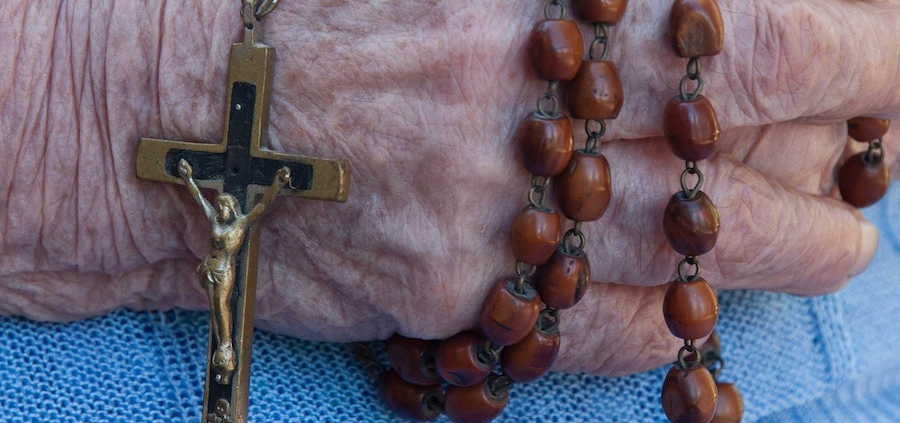Rosary Catholics and a New Church by Hank Mattimore
A rosary is a string of beads upon which one says a series of prayers consisting of an introductory Creed, three Hail Marys, a Glory Be prayer, and then five decades of 10 Hail Marys with an Our Father and a Glory Be interspersed between the decades. Usually the Salve Regina is recited when concluding the rosary. Depending on the time one chooses to spend reflecting on the words of the prayers or the life of Jesus, saying the rosary normally takes about 15 minutes.
When my brother Dan was dying, I found myself saying the rosary with him. Dan was a Catholic in the pre–Vatican II mode, so saying the rosary came naturally to him. For me, not so much. Like many of my contemporaries, I had embraced the dramatic changes in the practices of Catholicism wrought by Vatican II. Saying the rosary took its diminished place along with novenas, May crownings, 40 Hours’ Devotions, and indulgences as part of an old church that had been replaced with a new look and spirit. It had been years since my fingers held the beads, and while the words of the Hail Mary and the Lord’s Prayer came back easily enough, I had to stretch my memory to determine whether we were supposed to say the sorrowful mysteries on Tuesdays, or was that the glorious mysteries? . . .
But to my surprise, I discovered that saying the rosary touched a chord in me that I hadn’t experienced for a long time. Was it just nostalgia for the prayers of my youth? Or perhaps being with my brother, who I had been very close to growing up, brought back to mind the family rosaries we had prayed as kids. Whatever the reason, I was moved.
Flash forward two years later, and I am present with a close friend, Theresa, who is under hospice care with little chance of surviving more than a few weeks. Theresa is a former nun and very much a Vatican II Catholic, and she gave me a shock by sharing that she was finding great comfort in praying the rosary. My mind went back to the time I spent with my brother in his last moments. I could relate.
Reflecting on her rediscovering of the rosary, Theresa said, “There is a kind of symphony that happens when my tongue utters words while my fingers touch the beads. It’s hard to explain but it relaxes me. I feel more accepting of what God is asking of me.” I love my friend and wanted to help her in the closing moments of her journey, so I told her that when I returned home, I would also pray the rosary for her every night until she recovered her health or until God welcomed her into heaven.
Weeks have passed and I have kept my promise to Theresa (except for the two nights I fell asleep in the middle of reciting the beads). It felt a bit strange at first, but little by little I have been nourished by the same aura of peace that Theresa had experienced. I expected to be bored by the constant repetition of the Hail Marys and the Our Fathers, but the physical act of fingering the beads seemed to fit with reciting the words so that they belonged together. Far from being boring or distracting, I found it comforting.
But I have been experiencing something more profound than a feeling of comfort while saying the beads. Perhaps it is the discipline of keeping my promise to Theresa: the very practice of repeating these sacred words over and over again helps me pay attention to them on a deeper level. With the help of God’s grace, I am thinking and spending time doing something for another person. And I am doing it consistently and consciously.
My experience of resuming the practice of returning to the rosary after many years is a personal one. I am not beating the drum for all my liberal Catholic friends to resurrect a “rosary crusade” for the 21st century. God touches each of us in different ways. He has used this way to get me back in touch with my faith, and I am grateful for this intervention in my life. Saying the rosary has raised my consciousness to the extent that I have grown more attentive to my calling as a Christian. The very act of “saying my prayers” is making me a better person. For me, at least, praying the rosary is time well spent.
Hank Mattimore is a noncanonical Catholic priest and a former Oblate of Mary Immaculate. For many years he was a spiritual adviser at the Sonoma County, California, Juvenile Hall. He can be reached at hankmattimore12@gmail.com.





The rosary has never been my favorite prayer, but it is definitely my go-to-prayer in times of great need. I am happy for Hank & others who have found new comfort from an old tradition.
Moving beyond the traditional mysteries, I find using other gospel scenes along the way offers particularly challenging prayer experiences for me.
Having read Hank Mattimore’s “Rosary Catholics and a New Church” I feel inspired to return to my practice of saying the rosary. It’s a wonderful way to meditate. I too, will offer these prayers for our beloved friend, Theresa.